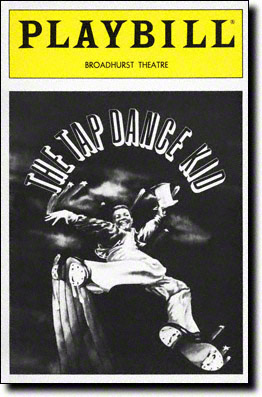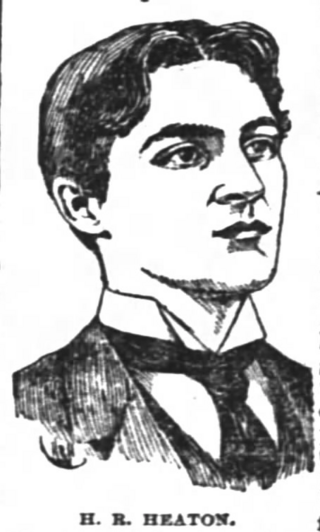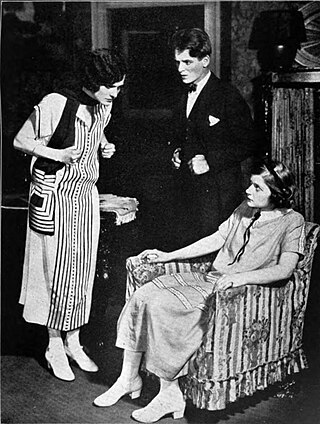
Roland Young was an English-born actor. He began his acting career on the London stage, but later found success in America and received an Academy Award nomination for his role in the film Topper (1937).
Night Hostess is a 1928 play in three acts written by Philip Dunning. Its author called it a Dramatic comedy, but most contemporary reviewers said it was a melodrama. It has a large cast, fast pacing, and one setting. The main storyline concerns a crooked nightclub manager who is robbing customers and cheating the owner, complicated by two murders and a romantic triangle.

Robert Wesley Addy was an American actor of stage, television, and film.

The Tap Dance Kid is a musical based on the novel Nobody's Family is Going to Change by Louise Fitzhugh. It was written by Charles Blackwell with music by Henry Krieger and lyrics by Robert Lorick.

Hell's Bells AKA Fool's Gold, is a 1924 play in three acts written by Barry Conners. It is a farce with a large cast and one setting. The story concerns two middle-aged Arizona-based prospecters, sent back East by a speculator to sell shares in his mine. To expedite sales, they pose as millionaires, which leads the Connecticut sisters of one prospector to have him committed so they can obtain control of his supposed wealth.
The Noose is a 1926 play in three acts written by Willard Mack. It is a melodrama, with a large cast, fast pacing, and two settings. The story tells of a young man condemned for the murder of a fellow bootlegger, and his refusal to explain why he did it.

The Old Maid is a 1934 play by American playwright Zoë Akins, adapted from Edith Wharton's 1924 novella of the same name. The play as published has six "episodes", covering twenty-one years of time. It has a large cast, and three settings; one is used for the last four episodes (scenes). The story concerns two women, cousins, who allow rancor over a lost love to become a struggle for the illegitimate daughter of one.
Murray Kinnell was a British-born American actor, recognized for playing smooth, gentlemanly, although rather shady characters. He began acting on the English stage in 1907, toured in the United States from 1912 through 1914, then returned to England where he served in the British Army during World War I. After the war, he emigrated to the US. He appeared in 71 films between the pre-code era of 1930 and 1937. He later served the Screen Actors Guild in several positions for 16 years.
First Lady is a 1935 play written by Katharine Dayton and George S. Kaufman. It is a three-act comedy, with three settings and a large cast. There are four scenes, which occur at monthly intervals starting with the December prior to a presidential election year. The story concerns a Washington, D.C. socialite who almost lets her rivalry with another social maven impede her husband's political future. The title is a play on the usual term accorded to a President's wife, suggesting it really belongs to the leading society hostess in the capitol.

Harold Robertson Heaton was a newspaper artist whose work focused on cartoons. His prodigious body of work contributed to the development of political cartoons. He also illustrated books and produced sketches and paintings. He left newspaper work in 1899 to begin acting on the stage, and later wrote plays as well. He returned to cartooning for six years beginning in 1908, but continued acting while doing so. He appeared in many Broadway productions through 1932. A brief retrospective on his employment with the Chicago Tribune, from October 1942, mentioned his obituary had been printed "a few years ago".

Elizabeth the Queen was a 1930 Broadway three-act play written in blank verse by Maxwell Anderson, produced by the Theatre Guild, directed by Philip Moeller and with scenic and costume design by Lee Simonson. It ran for 147 performances from November 3, 1930, to March 1931 at the Guild Theatre. The starring roles were played by Lynn Fontanne as Elizabeth and Alfred Lunt as Lord Essex.

Willie Howard and Eugene Howard, billed as the Howard Brothers, were Silesian-born American vaudeville performers of the first half of the 20th century. They were two of the earliest openly Jewish performers on the American stage.

Harmony at Home is a 1930 pre-Code domestic-comedy film directed by Hamilton MacFadden. It was produced and distributed by Fox Film Corporation. It was based on a 1925 Broadway play, The Family Upstairs by actor, writer, composer Harry Delf.

The Family Upstairs is a 1926 American silent comedy film directed by John G. Blystone and starring Virginia Valli, Allan Simpson, and J. Farrell MacDonald. It was based on the 1925 Broadway play of the same name by Harry Delf.

Winnie Baldwin was an American vaudevillian, film actress, and playwright.

Louise Alexander, born Jennie Louise Spalding, was an American theatrical and social exhibition dancer between 1905 and 1916. She began as a chorus girl, soon became a pantomime dancer, then an exhibition social dancer in restaurants and on the vaudeville stage.
Anniversary Waltz is a three-act play, written by Jerome Chodorov and Joseph Fields, and staged by Moss Hart. It is a comedy with a simple plot, medium-sized cast, fast pacing, and only one setting. The action varies from farce to schmaltz, as the Walters celebrate their fifteenth wedding anniversary only to have a family secret go public and send everyone into a frenzy.

José Ruben was a French-born actor whose career from 1910 on was in the United States. He first rose to prominence in 1916-1917 with the Washington Square Players, and for the next ten years was a highly regarded lead player. He acted in over twenty silent films and was a fixture on Broadway stages, as both performer and director, for over forty years. He also taught drama at Barnard College and was a stage director for the New York City Opera.
Harry Delf was an American comedian, stage actor, playwright, both a screen writer and director of short films, theatrical producer, and lyricist and composer for musicals. He is best remembered as the author of the play The Family Upstairs (1925) which has been staged on Broadway twice and adapted into a film multiple times. As a comedian and stage actor he performed in vaudeville and on Broadway.

Pigs is a 1924 play written by Anne Morrison and Patterson McNutt. It is a three-act comedy with four scenes. It has a medium-sized cast, two settings, and fast pacing. The story concerns a young man who senses a great business opportunity in some ailing pigs. With the help of a young woman and his mother, he demonstrates his veterinary skills and saves the family home.














